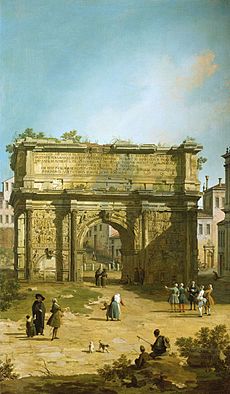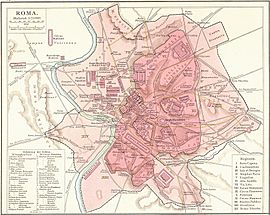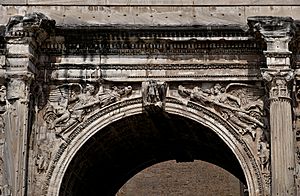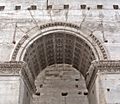Arch of Septimius Severus facts for kids

Arch of Septimius Severus
|
|
| Location | Regio VIII Forum Romanum |
|---|---|
| Coordinates | 41°53′34″N 12°29′05″E / 41.892758°N 12.484744°E |
| Type | Triumphal arch |
| History | |
| Builder | Septimius Severus |
| Founded | 203 AD |
The Arch of Septimius Severus (Italian: Arco di Settimio Severo) is a famous triumphal arch in Rome, Italy. It stands at the northwest end of the Roman Forum. This impressive arch is made of white marble and was built in 203 A.D.
It was created to celebrate the victories of Emperor Septimius Severus and his two sons, Caracalla and Geta. They won important wars against the Parthian Empire between 194 and 199 A.D.
After Emperor Septimius Severus died, his sons Caracalla and Geta ruled together. But Caracalla had Geta killed in 212 A.D. Then, Caracalla ordered that all mentions and images of Geta be removed from public places. This practice is called damnatio memoriae, which means "condemnation of memory." So, Geta's name and image were removed from the arch.
Contents
What the Arch Looks Like
The Arch of Septimius Severus was built on a stone base. Steps led up to it from the ancient Roman Forum. The arch has three main openings. The largest one is in the middle, and two smaller ones are on each side. These side openings connect to the central archway.
The arch is about 23 meters (75 feet) tall and 25 meters (82 feet) wide. It has two main sets of carvings, called reliefs. Four large panels are on the upper part of the arch, called the attic. Eight smaller panels are inside the four archways.

The three archways are supported by strong columns. These columns have detailed carvings. You can see Winged Victories carved into the curved spaces above the arches. These figures represent victory.
A staircase inside one of the columns leads to the top of the arch. Long ago, statues of the emperor and his two sons stood on top. They were shown in a chariot pulled by four horses, along with soldiers.
We don't know who the main architect was. But the arch was built quickly and followed traditional Roman styles. Even so, it shows some new ideas in how textures and shapes were used. Many different artists likely worked on the arch. This helped finish the project fast. Experts can see small differences in the carvings, suggesting many hands were involved.
The arch uses columns and carvings that create deep shadows. This makes the front of the arch look more detailed and grand. It gives the illusion of a deep porch, even though it's not actually there.
Building Materials
The Arch of Septimius Severus is mostly made of travertine stone and marble. It also uses concrete and brick inside. Different types of marble were used for different parts. For example, Proconnesian marble was used for the columns.
The marble blocks were cut very precisely into rectangular shapes. They fit together very tightly, which is amazing for how old the arch is. It's thought that the blocks were cut and roughly shaped on the ground. Then, once they were in place, the fine details were carved. This careful planning helped create such a strong and beautiful monument.
Decorations and Meaning
The decorations on the arch were very important. They were meant to show off the emperor's victories and power. The arch's design shows how Roman art often combined tall, vertical lines with horizontal decorations.
The top part of the arch, the attic, was decorated to celebrate the emperor's family. Old coins show that there used to be a chariot pulled by six horses on top. It was made of gilded (gold-covered) bronze. These statues probably looked like they were carrying trophies.
The large letters of the inscription on the arch were also gilded. This would have made them shine brightly in the sun. The arch also has decorative carvings like rosettes and Acanthus leaves. These designs were common in Roman imperial buildings.
Stories in Stone: The Reliefs
The arch is covered with many carved scenes, called reliefs. Near the archways, you can see flying Victorias. These figures symbolize the emperor's victories. Below them are four statues that represent the four seasons.
On the pedestals (bases) of the columns, you can see carvings of war prisoners. As people walked through the arch, these images would remind them of Rome's power. Some prisoners look sad, while others have their hands tied behind their backs. Roman soldiers stand behind them.
Carvings also show the treasures and goods taken by Septimius Severus's army. These are shown being carried on a cart pulled by a large animal. The arch has four main relief panels that tell the story of Rome's wars against the Parthian Empire.
Relief One: The Siege of Nisibis
This panel shows the siege of Nisibis from 195 A.D. This city was important because it started the first war against the Parthians. A knight guards the city gate, representing the knight Septimius Severus chose to protect Nisibis after the war. The small building at the bottom shows the Roman camp during the siege. Many figures represent the battle where Severus defeated his enemies.
Relief Two: Surrender or Agreement?
This scene has different meanings to experts. One idea is that it shows the city of Edessa, a Roman ally, surrendering. The bottom part looks like a battle, but it might be a surrender by King Abgarus to the emperor. The king is shown giving in to the emperor.
Another idea is that this panel shows an agreement between Emperor Severus and the city of Hatra. The emperor holds his spear pointing down, which suggests he is not being aggressive. The other figure is not kneeling, which goes against the idea of surrender.
Relief Three: Attacking Seleucia
This panel shows the second Parthian war campaign. On the left, Roman soldiers are attacking the city of Seleucia. Parthian soldiers are running away on both sides. At the top, citizens are shown surrendering to the Romans.
Relief Four: Taking Ctesiphon
The relief on the right shows the Romans taking over the city of Ctesiphon. This was the final battle of the Parthian war. You can see a large siege machine at the bottom left, showing it's a city attack. To the right, the city is shown surrendering to the Romans. The top right part shows Emperor Septimius Severus announcing his oldest son, Caracalla, as co-ruler. His younger son, Geta, is shown as the crowned prince.
A Story of Power and Family
After the second century A.D., Roman emperors often built triumphal arches. These arches were a way to show off their achievements to everyone. The Arch of Septimius Severus was a powerful tool for showing off the emperor's rule. It was built to celebrate his victory against the Parthians. But it also showed the strength of the Severan family.
The Parthian war started in 197 C.E. Septimius Severus went to Nisibis in Mesopotamia to take back the city. After taking Nisibis, he led his army to other Parthian cities, including Seleucia and the capital city Ctesiphon. These wars helped Rome gain control of Northern Mesopotamia.
Coins with images of the arch were made by Septimius and Caracalla. This helped show the Roman people that the arch was finished. Emperor Septimius Severus had planned for his sons, Geta and Caracalla, to rule together. But after Septimius Severus died, Geta was killed by his brother Caracalla.
Where the Arch Stands
Many triumphal arches in Rome are on the Via Sacra, a special road for victory parades. But the Arch of Septimius Severus stands on its own. Because of its location, only people walking could see it up close.
The arch was built after eight years without any new big projects in the Roman Forum. It showed the emperor's loyalty to Rome and kept old traditions alive. Before this arch, a bronze statue of an emperor on horseback stood here. The arch also connects the Senate building and the emperor's power.
Damage and How It Was Saved
The arch has some damaged areas. The carved panels are worn away by weather and pollution. Dark crusts have formed on the marble. Fire damage can be seen on one panel, where the marble looks burned. Some parts of the arch's top are also damaged. But overall, the arch is in good condition. This is thanks to the skilled builders of the Severan Dynasty.
The arch stands near the Capitoline Hill. Over time, dirt and debris from the hills covered the lower parts of the arch. By the 4th century, the ground level had risen so much that a road was built through the arch. You can still see damage on the column bases from carts and wagons that passed through in medieval times.
During the Middle Ages, floods brought more dirt into the Roman Forum. By 1742, when the artist Canaletto painted it, only the top half of the arch was visible above ground. The arch is so well preserved because it was made part of a Christian church in 1199. Later, the Cimino family also helped protect it. They even built a tower on top of the arch! When the church moved, the arch remained church property, so it wasn't torn down for other buildings.
The Special Inscription
The inscription on the arch is one of its most important features. It tells us who built the arch and why.
The inscription reads:
IMP · CAES · LVCIO · SEPTIMIO · M · FIL · SEVERO · PIO · PERTINACI · AVG · PATRI PATRIAE PARTHICO · ARABICO · ET PARTHICO · ADIABENICO · PONTIFIC · MAXIMO · TRIBUNIC · POTEST · XI · IMP · XI · COS · III · PROCOS · ET IMP · CAES · M · AVRELIO · L · FIL · ANTONINO · AVG · PIO · FELICI · TRIBUNIC · POTEST · VI · COS · PROCOS · (P · P · OPTIMIS · FORTISSIMISQVE · PRINCIPIBUS) OB · REM · PVBLICAM · RESTITVTAM · IMPERIVMQVE · POPVLI · ROMANI · PROPAGATVM · INSIGNIBVS · VIRTVTIBVS · EORVM · DOMI · FORISQVE · S · P · Q · R
In English, this means:
"To the emperor Caesar Lucius Septimius Severus Pius Pertinax Augustus Parthicus Arabicus Parthicus Adiabenicus, son of Marcus, father of his country, Pontifex Maximus, in the eleventh year of his tribunician power, in the eleventh year of his rule, consul thrice, and proconsul, and to the emperor Caesar Marcus Aurelius Antoninus Augustus Pius Felix, son of Lucius, in the sixth year of his tribunician power, consul, and proconsul (fathers of their country, the best and bravest emperors), on account of the restored republic and the rule of the Roman people spread by their outstanding virtues at home and abroad, the Senate and the People of Rome (sc. dedicate this monument)"
When the arch was dedicated, Septimius Severus was ruling with his son Caracalla (Marcus Aurelius Antoninus). The part in parentheses in the middle of the inscription replaced the original words about his other son, Geta. Caracalla had Geta's name removed from history after Geta was killed.
Gallery
See also
 In Spanish: Arco de Septimio Severo para niños
In Spanish: Arco de Septimio Severo para niños
- Arch of Titus
- List of Roman triumphal arches
- List of ancient monuments in Rome











